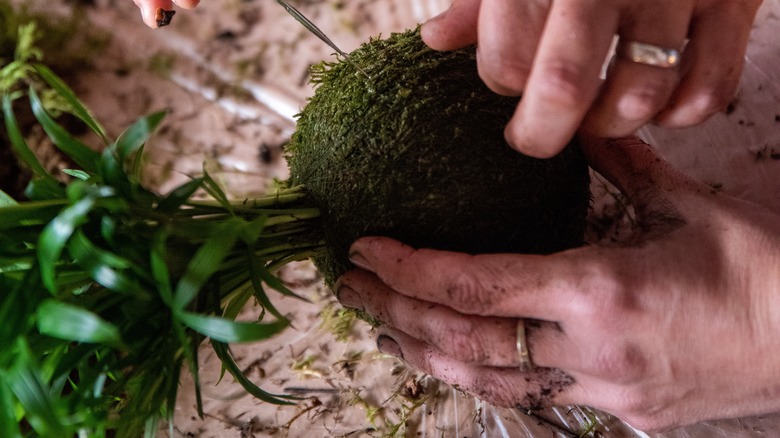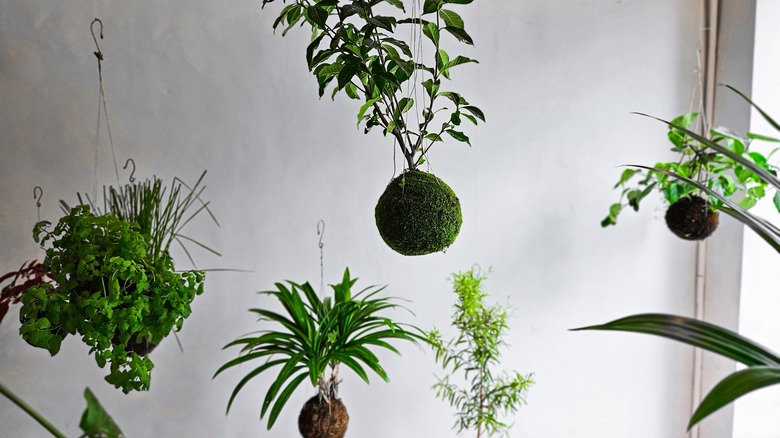The Plant Trend Featured On HGTV's Farmhouse Fixer & How To Get The Look
We couldn't help but admire the innovative, chic hanging plant design in a recent episode of "Farmhouse Fixer." As part of their kitchen makeover, hosts Jonathan Knight and Kristina Crestin added pothos rooted in hanging moss balls to a rustic ladder over the kitchen island, interspersing the foliage between Edison bulbs. This mossy, sculptural plant trend is called kokedama — from the Japanese koke (moss) and dama (ball) — and it originates from the bonsai tradition. Per the Kew Royal Botanical Gardens, kokedama moss balls are often referred to "as 'the poor man's bonsai' or the 'lazy man's bonsai' as they need much less attention to grow."
Kokedama can be a low-maintenance, beautiful addition to the popular Japandi style in your home. Japandi, a combination of Japanese and Scandinavian philosophies of decor, emphasizes cozy, minimalist design with natural accents. If you're looking for simple Japandi additions to your home, or just want to try your hand at a new style of gardening, kokedama is a great starting point.
How to make a kokedama moss ball
To make a kokedama, you'll need a houseplant, potting soil, sphagnum moss, and fishing wire or twine. When we made a pet-proof kokedama moss ball, we first soaked our houseplant's roots and soil thoroughly to shape the root ball into a sphere of soil. If you're starting with a bare-root plant, be sure that your potting soil is thoroughly saturated with water before shaping it around your houseplant's roots; the soil should be damp enough to hold its shape once sculpted into a ball. Soak your sheet moss in a bowl of water before wrapping it around your ball of soil, then wrap your twine or wire around the ball to secure the moss. Once your string has been tied off neatly, add an additional string or leave a long tail if you wish to suspend your kokedama from a hanger. You can also place your kokedama on a plant saucer if you prefer to place it on a windowsill or ledge.
Once your kokedama is made, care is pretty simple. Soak the entire moss ball in water for 5-30 minutes once a week — the ball will be hydrated when it goes from light to heavy. If you'd like to add fertilizer to your kokedama plant, just dissolve water-soluble fertilizer into the water you soak it in prior to hydration. To avoid scorching your plant or drying out your kokedama too quickly, place your kokedama in bright, indirect light or partial shade.
Selecting your kokedama plant(s)
You'll first need to select the plant you wish to grow using kokedama. It's best to avoid plants that require full sun, as the moss will need to remain fairly moist and risks drying out with prolonged sunlight exposure. If you're interested in following a more traditional bonsai route, you can cultivate miniature trees or shrubs using kokedama with juniper, ficus, or jade, but many kokedama fans simply use a low-maintenance houseplant in their DIY kokedama balls. Just remember that you're creating your own miniature environment for your plant that will be difficult to expand once established; for this reason, Missouri Botanical Garden recommends "plants with small root systems or slow growing."
Some ideal partial-shade plants that will thrive in a moss ball include pothos, ferns, philodendron, African violet, creeping fig, and peperomia. Vining plants that can be propagated by cuttings are especially good choices for kokedama, as they'll make for an attractive cascade of greenery that you can re-root upon pruning. If your kokedama placement will be on the sunnier side, succulents like kalanchoe, donkey's tail, and string-of-beads may be good options, as well as scorch-proof crotons or even kitchen herbs like basil, mint, or parsley.


